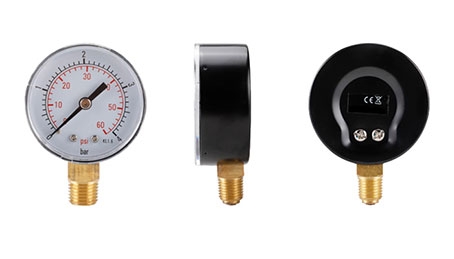Pressure gauge selection should be based on the use of process production requirements, for specific situations to do specific analysis. Under the premise of meeting the process requirements, which should be in line with the principle of saving a comprehensive and integrated consideration, sisco.com for you to organize the relevant information, in the selection of pressure gauges can generally consider the following aspects of the problem.
The Type of Selection
The selection of pressure gauge type must meet the requirements of the process production. For example, whether the need for remote transmission, automatic recording, or alarm.
The nature of the measured medium, such as the temperature of the measured medium, viscosity, size, corrosiveness, degree of dirt, whether flammable and explosive, etc., whether the pressure gauge put forward special requirements, the site environmental conditions, such as humidity, temperature, magnetic field strength, vibration, etc., are the type of pressure gauge requirements.
Therefore, according to the process requirements of the correct selection of pressure gauge type is to ensure the normal operation of the pressure gauge and the important premise of safe production. For example, the spring tube of the ordinary pressure gauge is mostly made of copper alloy, while the spring tube of the ammonia pressure gauge is mostly made of carbon steel, which does not allow the use of copper alloy. Because of the chemical reaction between ammonia and copper, it will explode, so the ordinary pressure gauge can not be used for ammonia pressure measurement.
The oxygen pressure gauge and ordinary pressure gauge in the structure and material can be the same, only the oxygen pressure gauge must be prohibited oil. Because the oil in the oxygen system is easy to cause an explosion. The oxygen pressure gauge used in calibration can not be used as an ordinary pressure gauge, because oil is the working medium, oxygen pressure gauge storage should strictly avoid contact with oil.
If you must use the existing pressure gauge with oil to measure the oxygen pressure, you must use carbon tetrachloride to clean it repeatedly before use, and check it carefully until there is no oil.

The Determination of the Measurement Range
- In order to ensure that the elastic element can work reliably within the safety range of elastic deformation, the selection of the pressure gauge range must be based on the size of the measured pressure, the pressure changes quickly, leaving enough room for error, so the upper limit of the pressure gauge should be higher than the maximum pressure value that may occur in the production process. According to "Chemical Automatic Control Design Technical Regulations", when measuring stable pressure, the maximum working pressure should not exceed 2/3 of the upper limit value of measurement.
- When measuring pulsating pressure, the maximum working pressure should not exceed 1/2 of the upper limit of measurement, and when measuring high pressure, the maximum working pressure should not exceed 3/5 of the upper limit of measurement.
- The minimum value of the measured pressure should not be less than 1/3 of the upper measurement limit of the pressure gauge to ensure a linear relationship between the output of the pressure gauge and the output
- Using the maximum and minimum values of the measured parameter to calculate the upper and lower limits of the instrument cannot be used directly as the measuring range of the pressure gauge. When we choose the upper limit of the range of the pressure gauge, we should choose it in the national standard series.
The Selection of Precision Level
According to the maximum absolute error permitted by the production process and the range of the selected pressure gauge, the maximum quoted error permitted by the pressure gauge is calculated, and the accuracy of the pressure gauge is determined in the national accuracy class.
Generally speaking, the higher the accuracy of the selected pressure gauge, the more accurate and reliable the measurement results will be. However, we should not assume that the higher the accuracy of the selected pressurizer, the better, because the higher the accuracy, the more expensive the pressurizer is in general, and the more laborious it is to operate and maintain.
Selection of Examples
- For the measurement of viscous or acidic and alkaline and other special media, should be selected diaphragm pressure gauge, stainless steel spring tube, stainless steel movement, stainless steel shell, or plastic wood shell.
- According to the different media measured, there should be a prescribed color code on the pressure gauge, and indicate the name of the special media, oxygen table must be marked with red "no oil" words, hydrogen with dark green under the horizontal line of the color code, ammonia with a yellow under the horizontal line of the color code and so on.
- Installed against the wall, should be used with the edge of the pressure gauge. Directly installed in the pipeline, should be used without the edge of the pressure gauge. For direct measurement of gas, should be used behind the case with a safety hole pressure gauge. For the consideration of pressure measurement position and easy observation and management, the size of the case diameter should be selected.
In summary, choosing the right pressure gauge requires a thorough understanding of your application requirements, gauge type, gauge characteristics, and environmental conditions. By considering the type of gauge, construction, material, measuring range, accuracy class selection, and cost, you can make an informed decision on the gauge that meets your specific needs.

